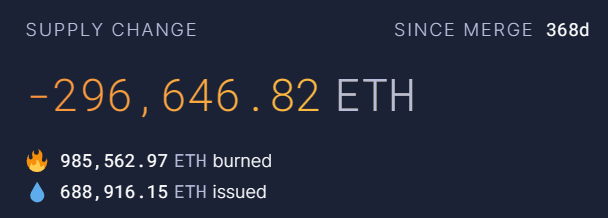One Year After The Merge: ETH Supply Shrinks But Challenges Remain
Nearly 1M ETH Has Been Burned Since Ethereum Transitioned To Proof-of-Stake, But Lido’s Dominance Of LST Sector Continues To Concern Decentralization Advocates
By: Samuel Haig • Loading...
DeFi
The Merge was tipped to be the most significant upgrade in Ethereum’s history, promising to make ETH a deflationary asset while significantly reducing the carbon footprint of the network.
While Ether has traded sideways over the past 12 months, much has changed for the network’s fundamentals. New Ether issuance is down more than 80%, staking participation is up 87%, and nearly 1M ETH has been permanently removed from supply.

But while Ethereum is largely making good on its deflationary promise, new challenges to the network’s decentralization have emerged.
Deflationary Ethereum
The Merge took place on Sept. 15, 2022, transitioning the network from Proof of Work to Proof of Stake consensus.
The shift overhauled Ethereum’s fundamental tokenomics, with new daily Ether issuance falling more than 80% from 13,500 ETH to currently around 2,300 ETH. Coupled with the introduction of Ethereum’s burn mechanism one year prior, analysts predicted Ethereum would become deflationary, meaning that more ETH is burned from base transaction fees than enters circulation as rewards for stakers.
There are now nearly 300,000 fewer ETH in existence than at the time of The Merge. For comparison, an additional 3.8M ETH ($6.2B) would have been issued under Proof of Work.
Challenges Posed By Liquid Staking
The Merge also gave rise to the 2023 boom in liquid staking tokens (LSTs) — assets representing an underlying position of staked Ether which can be easily traded on exchanges or used in DeFi applications.
Ethereum’s Shanghai upgrade also activated staked ETH withdrawals in April, reducing the price spread between ETH and popular liquid staking tokens and bolstering the adoption of LSTs. Today, 10.8M ETH or 42.5% of all staked Ether is held by liquid staking protocols.
ETH locked in Lido, the top LST protocol, increased 82% from 4.6M to 8.6M since the year began, according to Dune Analytics. Coinbase’s LST token, cbETH, also boasts 1.17M Ether locked after launching last September, followed by Rocket Pool’s rETH with 450,000.
However, with Lido now commanding one-third of staked Ether, many onlookers decry Lido as a centralizing threat to Ethereum, warning that a further increase in Lido dominance could facilitate governance attacks against the network if the protocol desired.
In May, Ethereum chief scientist, Vitalik Buterin, advocated that staking providers controlling more than 15% of staked ETH should actively raise user fees to deter adoption until their dominance falls.
“If a stake pool controls > 15%, it should be accepted and even *expected* for the pool to keep increasing its fee rate until it goes back below 15%,” Buterin tweeted.
Advertisement
Get the best of The Defiant directly in your inbox 💌
Know what matters in Web3 with The Defiant Daily newsletter, every weekday
90k+ investors informed every day. Unsubscribe anytime.